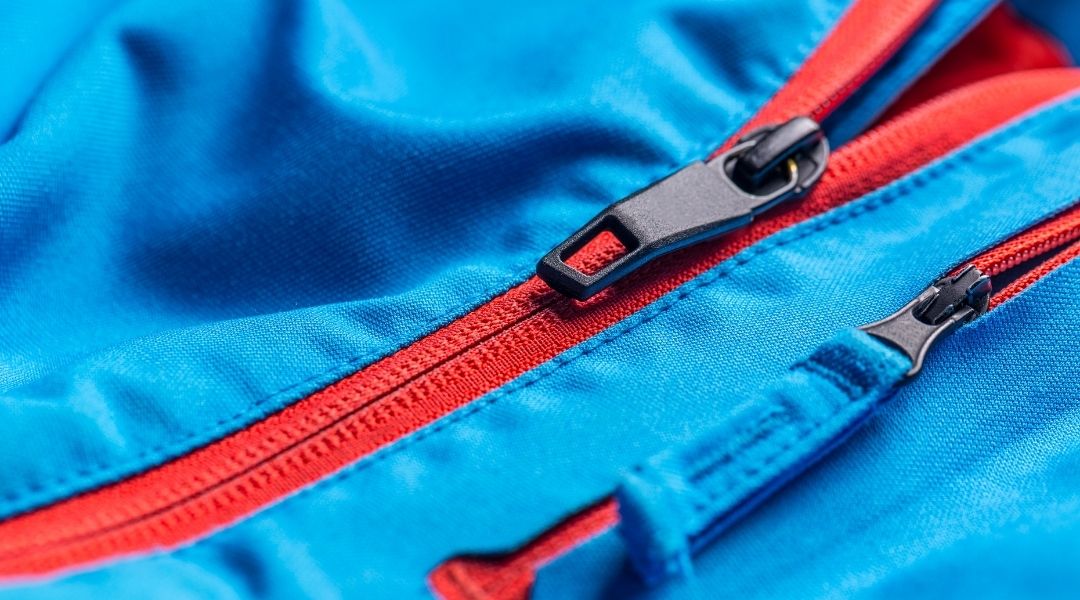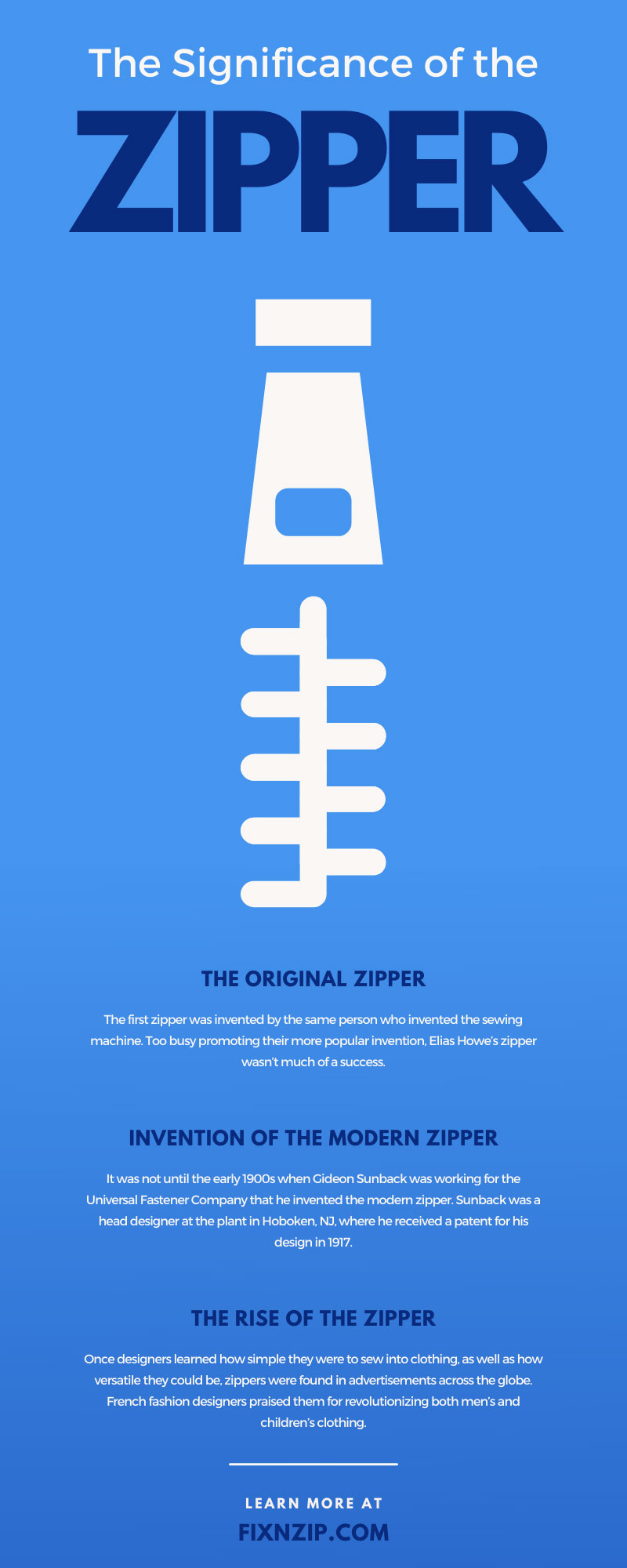
You probably don’t think much about the significance of the zipper. Often taken for granted, this masterfully engineered fastener is essential to most people’s daily lives. While you could live without it, modern life is made much more convenient by this seemingly simple device that is found on most jackets, backpacks, and pants. Learn about the history of this fastener and how it became so popular.
You may have never considered that zippers have a history. Zippers were invented more than 170 years ago, and now they’re the most popular fastener used today. The mechanism went through several rounds of engineering before it became the device that we all know.
The first zipper was invented by the same person who invented the sewing machine. Too busy promoting their more popular invention, Elias Howe’s zipper wasn’t much of a success. Whitcomb Judson improved upon Howe’s design in time for the 1893 Chicago World’s Fair. He called it a “clasp locker,” and again the invention was not successful.
It was not until the early 1900s when Gideon Sunback was working for the Universal Fastener Company that he invented the modern zipper. Sunback was a head designer at the plant in Hoboken, NJ, where he received a patent for his design in 1917. Further, Sunback also invented a machine to create the zipper. The first one could produce at least a few hundred feet of zipper chain per day.
The first zippers were advertised as shoe fasteners. The G.B. Goodrich company used them for their rubber boots and started calling the fasteners zippers. The common use of the term “zipper” is attributed to G.B. Goodrich. Additional original uses for zippers were for military equipment and uniforms during World War I.
How did zippers become part of mainstream fashion? Once designers learned how simple they were to sew into clothing, as well as how versatile they could be, zippers were found in advertisements across the globe. French fashion designers praised them for revolutionizing both men’s and children’s clothing. As the trend picked up in the United States, zippers became a preferred fastener to buttons or ties. Let’s next take a look at why the zipper is important in fashion.
When it comes to men’s fashion, zippers are less about aesthetic and more about function. Once designers realized how easy zippers made getting in and out of trousers, they knew men would love them. Zippers are easily concealed in men’s clothing but are also easily accessible so you can open your pants to use the restroom. Early advertisements for men’s pants with zippers were enticing because they played on the idea that those who wore them would have an easier time in the bathroom.
Zippers on women’s clothing are usually about ease. The zippers are typically hidden and may be found on jeans, a blouse, or a dress. Many modern women’s clothing and accessories also feature fashion zippers. Exposed zippers are common on handbags, boots, belts, and hats. Some zippers on women’s clothing don’t serve any function other than appearance. This shows how far our fashion industry has come with this unique fastener.
The zipper gained popularity due to the way it was advertised for children’s clothing. Ads explaining that pants with zippers gave children more independence had mothers buying them in bulk. Children who have more independence do better in school. Kids like being able to take care of themselves, too. Nothing is more significant than a piece of metal or plastic that can give your child more confidence.
In addition to daily fashion, zippers are essential to many other facets of life. They are the most common fastener used to keep bags and cases of all sorts closed. One of the most common uses for zippers is on jackets and coats. You wouldn’t buy a jacket that didn’t have a zipper, and you might stop using your jacket if the zipper broke.
Outdoor gear is another mainstream use for zippers. If you have a tent, boat, or other camping or marine equipment, it likely has a zipper to keep it secure. Zippers for outdoor gear are typically heavy- duty. For instance, marine zippers are water-resistant. Further, manufacturers use coil zippers for tents to ensure flexibility. You always want to buy top-quality gear to ensure it comes with a good zipper.
Prior to zippers, people used buttons and ties to fasten items like shoes and jackets. Since the invention of the zipper, it has inspired other fasteners, but none offer as strong of a hold. For instance, mechanisms for resealable bags and Velcro were designed based on zippers. While strong forms of Velcro exist, they aren’t as practical as zippers. Velcro wears down over time and is challenging to maintain.
Taking care of a zipper is easy if you know how to clean and properly maintain it. First, you should understand the most important parts of a zipper—the chain, teeth, slide, and pull tab. Your zipper shouldn’t be missing any teeth, and the slide shouldn’t wobble on the chain. The most common reason a zipper gets stuck is that something is caught in the teeth. You should remove threads, grime, and other gunk before trying to loosen the slide. Pull gently on the tab so you don’t break it.
To protect your zipper and ensure the slide glides over the chain properly, use a lubricant. You’ll know your zipper needs lubricant if the slide catches on the chain as you try to use it. The best things to use to grease your zipper are:
Sometimes, a zipper repair is necessary. You can sew in a brand-new zipper if you have the skills and time. Most people don’t have a sewing machine. If you suffer a zipper malfunction while on the go, you need a quick fix. A no-sew universal zipper repair kit is the perfect item to keep with you in case the zipper on your luggage, tent, or jacket suddenly stops working.
The zipper doesn’t stop evolving. We’ll always need to fasten our clothes, bags, and shelters. It’s not difficult to understand the significance of the zipper when you start looking for it in the world around you. You may use a zipper every day. If zippers are important to your lifestyle, get ahold of a FixNZip to help repair your items in an instant.

